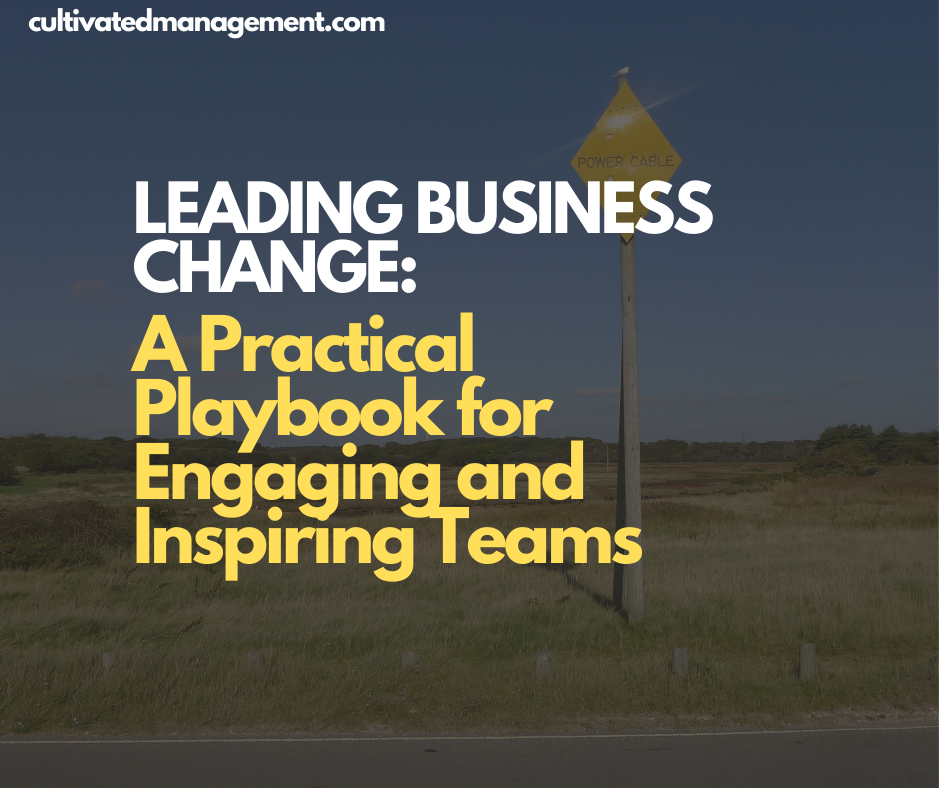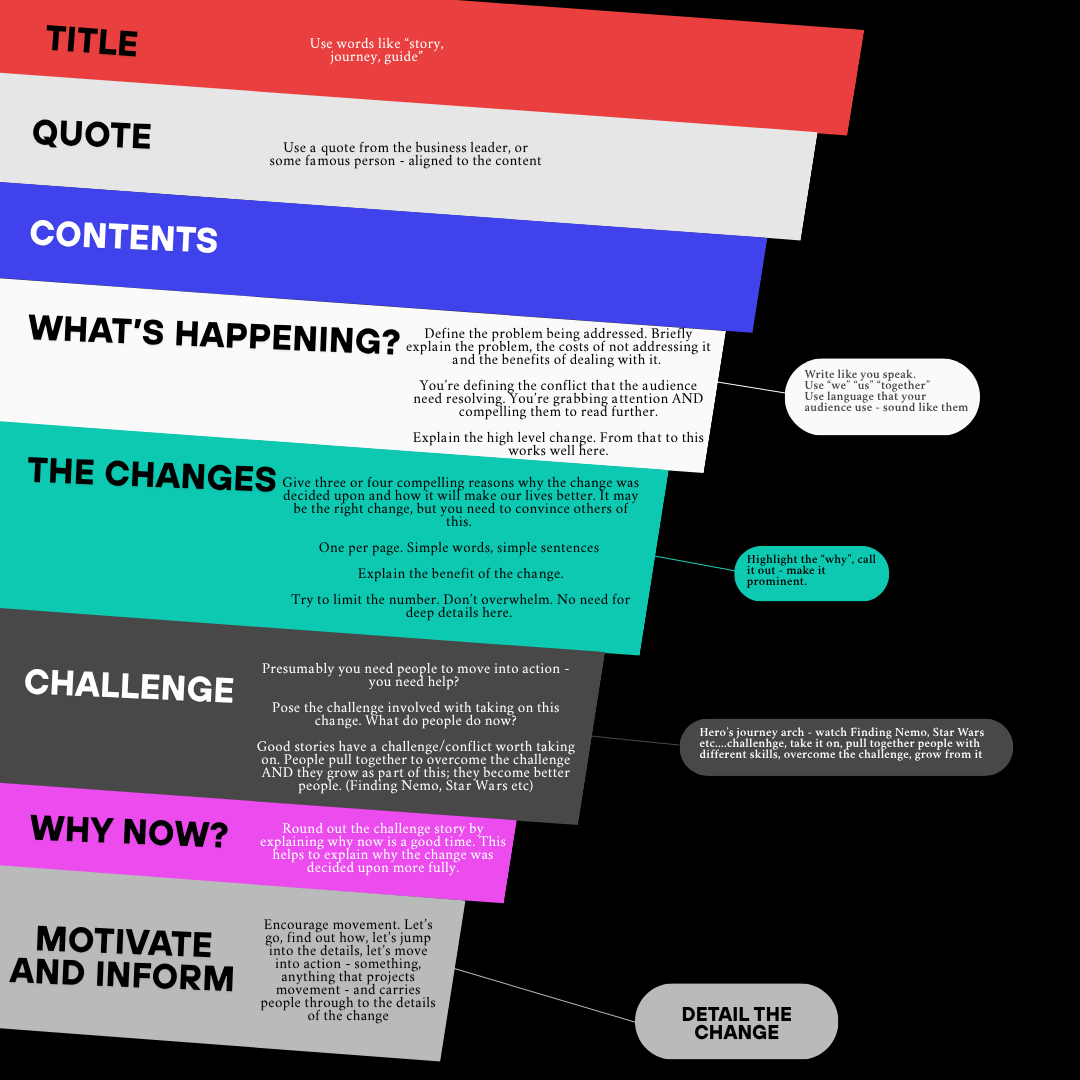
This is my personal playbook for leading business change and crafting compelling change content. The written artefacts you produce are not a replacement for dialogue, alignment, and action — but they serve a critical purpose.
People need something to read, to understand the change, and to spark conversations. A well-crafted guide or playbook can double as the backbone for presentations, meetings, or workshops.
I use the following structure all the time. It combines practical experience with proven communication techniques. If you want deeper guidance on writing, see the Communication Superpower guidebook.
Basic Principles
Before we dive into the model, a few fundamentals:
- Grab attention and keep it. If the reader loses interest early, the rest of your guidance won’t matter.
- Create value. No value, no engagement, no change. Every section should help the reader understand, feel, or act.
- Sound like your audience. Use words, phrases, and style they would use. Avoid corporate jargon unless unavoidable.
- Pose a problem. Explain it clearly, outline its cost if left unresolved, and tease the benefits if addressed.
- Create a challenge. A challenge must be exciting and difficult, not just hard. It should energise and inspire.
- Make the change clear. People need to understand what is changing, why it matters, and why now.
- Forward momentum. Keep sentences and sections moving. Forward motion keeps people engaged.
Writing for Change: The Core Structure

Title
Don’t make it boring. Words like Story, Guide, or Journey signal engagement. Examples:
- The Agile Transformation Story
- The HR Optimisation Journey
A compelling title sets the tone.
Quote
Open with a quote if possible. Ideally, this comes from a business leader or the CEO, explaining why the change is essential. If unavailable, use a trusted, respected external source. A quote anchors your narrative and builds credibility.
Contents
A simple, clean contents page is often overlooked but helps readers navigate and understand the guide’s structure.
What’s Happening?
This section introduces the problem your change addresses.
- Pose the problem. Keep it concise, clear, and relatable. All businesses have many issues; focus on the one this change solves. All problems have costs and benefits...
- Explain the cost. What happens if we do nothing? Be concrete: lost time, inefficiency, frustration.
- Outline the benefits. How will lives improve? How will work be easier? Be tangible. Three strong benefits are enough—too many dilute the message.
- High-level resolution. Explain what will change. Use a “Before → After” approach for clarity:
Before: We used spreadsheets to manage HR data.
After: We’re using a tool that simplifies, aligns, and provides real-time reporting.
Keep this section short—a page or slide at most—but compelling.
The Changes (Benefits)
Here, explain why the change was chosen and the benefits it brings.
Even after careful analysis, people need to be convinced that this is the right change. Pull on their heartstrings and explain the personal and organisational impact. Keep it simple, compelling, and rich:
Example: HR Tool Implementation
- Simplifies all HR processes.
- Removes tedious spreadsheet work, providing accurate, real-time data.
- Saves hours of manual entry, freeing the team for higher-value work.
Example: Agile Ways of Working
- Streamlines time between idea and delivery.
- Encourages autonomy and localised decision-making.
- Reduces delays and improves feedback loops.
Use “we”, “us”, “together” to make it personal. Keep momentum moving — use phrases like “Let’s go” or “Find out more on the next page” or "keep reading."
Challenge
After explaining the change, pose a challenge.
This is the essence of storytelling: the obstacle that must be overcome. It should be:
- Hard, tricky, and incomplete.
- Likely to throw curveballs.
- Exciting, compelling, and motivational.
Emphasise that everyone has a role, that success requires collaboration, and that the journey will deliver personal growth alongside organisational benefits.
Why Now?
Explain why this change is happening now. Timing matters:
- Costs of the problem may be increasing.
- Resources, funding, or skills may now be available.
- Market or organisational conditions may demand immediate action.
Use clear, simple language: “We, together, can make this change now.” Ground the urgency in relevance and opportunity.
Motivate and Inform
By now, your guide should be no longer than 12–15 pages. Keep it light, easy to read, and motivational.
Open this section with a line like:
“Let’s jump into the details to see how we all play a part.”
Then, outline the practical elements of the change:
- Timelines and milestones.
- Leadership and responsibilities.
- Roles of team members.
- Training and awareness initiatives.
- Technical or process details.
- Working groups and communication channels.
The aim is to give people a clear view of how they will contribute without overwhelming them.
Why This Works
This approach works because it respects the reader’s attention and mental bandwidth. Too often, change guidance dives into technical detail without first grounding the reader in:
- The problem.
- The costs of inaction.
- The benefits of action.
- Why the proposed solution is the right one.
By starting with the problem and benefits, then explaining the solution, posing a challenge, and finally detailing the implementation, you create a compelling narrative that keeps people engaged.
The structure mirrors great storytelling:
- Pose the problem.
- Take on the challenge.
- Overcome the problem.
- Learn and iterate.
It works in presentations, written guides, and conversations.
Applying the Playbook
This framework is scalable:
- Small change projects: Use it to explain a new process in your team.
- Large initiatives: Structure corporate-wide transformation with the same approach.
- Personal development: Apply the model to coaching or mentoring conversations.
It works because humans respond to clear stories, challenges, and tangible benefits. Your audience must see themselves in the narrative — they need to feel the problem, understand the solution, and recognise their role in making it happen.
👉 If you're interested in learning about business storytelling, check out the Storytelling Masterclass with a Sunday Times Top Ten best selling author.
Key Takeaways
- Grab attention early with a compelling title and quote.
- Pose the problem clearly and explain the cost of inaction.
- Explain the benefits of the change in simple, personal language.
- Pose a challenge that is exciting, hard, and motivating.
- Explain why now to create urgency.
- Motivate and inform with practical details, responsibilities, and timelines.
- Keep the narrative moving—language and structure must drive momentum.
- Align the audience with personal, organisational, and emotional stakes.
By following this framework, you ensure your change guidance is compelling, engaging, and valuable to the people who need to read it.
Whether it’s a team restructure, a new tool, or a cultural transformation, the principles remain the same:
- Problem first.
- Solution second.
- Challenge third.
- Details last.
This is how you connect people to the change, gain buy-in, and inspire action.
Trinity of Effective Communication Bundle: Get Zero to Keynote, Workshop Mastery, and the Communication Superpower course—all in one powerful package.
